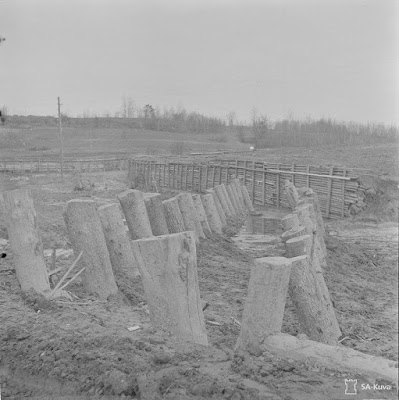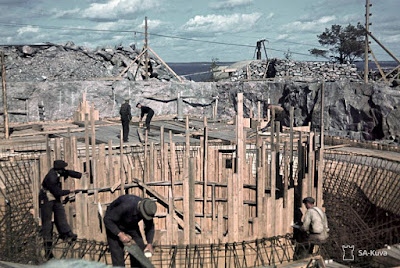ihaksela bridge. 1944.08.15
Road-bridge over to Suojujoki, area Lake Syamozero-Teru. June 1942.
Fortress Site: Fence ramming the piles. Behind the measurement tower.
kuittinen 1942.05.07
-------------
The Finnish plans for the offensive in Ladoga Karelia were completed on 28 June.
The offensive was launched on 10 July, and by 16 July, the Finns reached the shore of Lake Ladoga and cut the defending Soviet army in two, hindering the Soviets' defense of the area. Finnish headquarters halted the offensive in Ladoga Karelia on 25 July after reconquering the area of Ladoga Karelia lost to the Soviet Union in 1940 and after advancing as far as Vitele. The Finnish offensive then shifted to other sections of the front
The Finnish offensive in East Karelia started in early July in the northern section of the front. In early September, the attack in the northern section reached Rukajärvi (Ругозеро, Rugozero) village and Finnish headquarters halted the offensive there. On August 27, Finnish headquarters ordered the offensive in the south to reach the Svir River. Finnish troops cut the Kirov railroad on 7 September, crossed the Svir on 15 September, and then halted the offensive.
Advance troops reached the shores of Lake Onega on 24 September. The town of Petrozavodsk was captured on 1 October after the Soviets withdrew to avoid encirclement. On 6 November, Finnish headquarters ordered their forces to capture Karhumäki and then shift to defense. The Finnish forces captured the area of Karhumäki and Povenets, and halted the offensive in early December.
Related to the Finnish advance to the Svir, the German Army Group North advanced from the south towards the Svir River and managed to capture Tikhvin before Soviet counterattacks forced the Germans to withdraw to the Volkhov River. Soviet forces also made several attempts to force the Finns out from their bridgehead south of the Svir during October and December 1941; however, the Soviet efforts to reduce the bridgehead were blocked by the Finns. Soviet forces also attacked the German 163rd Division, which was operating under Finnish command across the Svir in October 1941, but the Soviet forces that had crossed the river were pushed back soon after.
------------
Front-line dugout, kind over the past has been built. 7-fold log roof and front of the blockhouse built to guarantee the inhabitants of the asylum also a heavy grenade concentration time. Rukajärvi, Tunkua road direction 1944.03.23
-----------------------------------------
Etulinjan korsu, jollaisia viimeaikana on rakennettu. 7-kertainen hirsikatto ja eteen rakennettu hirsivarustus takaa asukkaille turvapaikka myös raskas kranaattikeskitys aika. Rukajärvi, Tunkua tie suunta 1944.03.23--------------------------------------------------------------------
The Finnish II Corps (II AK) started its offensive in the region of the Karelian Isthmus on 31 July. Finnish troops reached the shores of Lake Ladoga on 9 August, surrounding most of three defending Soviet divisions on the northwestern coast of the lake; the Soviet divisions were evacuated across the lake. On 22 August, the Finnish IV AK Corps started its offensive from the 1940 border between the Gulf of Finland and the II AK, and advanced towards Viborg. By 23 August, the Finnish II Corps had reached the Vuoksi waterway from the east and continued to surround the Soviet forces defending Viborg.
The Soviet withdrawal order came too late, and the Soviet divisions lost much of their equipment, although a sizable portion of their manpower was later evacuated via the Koivisto islands. The badly mauled defending Soviet army was unable to halt the Finnish offensive, and by 2 September the Finns had reached the 1939 border along its whole length. On 31 August, Finnish headquarters ordered the 2nd and 4th Army Corps, which had advanced the furthest, to halt their offensive after reaching a line just past the former border that ran from the mouth of the River Sestra via Retukylä, Aleksandrovka, and the eastern edge of the village of S. Beloostrov (Russian: Старого Белоо́стров) to Ohta and form for defense.
3K / 4 Rj.P the command dugout Tapio. most closely resembles a tombstone.
Svir 1942.09.04
Closeup Infantry Regiment 6 in the command post. White Island 1944.05.15
Information Jukola company commander villa. Around the corner Lieutenant Green-Lake shows the toilet seats. Ontrosenvaara 1941.10.03
Jukola Tiedotuskomppanian huvila. Nurkan takana Luutnantti Viherjärvi osoittaa käymälän paikkaa. Ontrosenvaara 1941.10.03
after all, they are nice looking dugouts, Hovi and chateaux, but certainly capable of this Retuperä (in a bad way) compete with them. Karelia Isthmus. April 1942.05.08
II / 10 Field Artillery Regiment's transportation officer's dugout. Metsäpirtti.
Inf Reg 16. Area 1943.07.16
The beautiful totem pole in front of the dugout.
Fair drunkenness street. Syvärin lohko I/FGR 2. ja Inf Reg 30. 1942.06.23
German dugout apartment is finished, the address Hansa-Allee 30 / Hansa Allee 30 - it is the German captain's home address in Frankfurt. Alakurtti (Salla) 1941.09.26
The cottage is disguised Wood Stack. Virolahti 1941.07.01
------------------------------
According to Soviet sources, the Finns advanced and took the settlement of Novyi Beloostrov with its train station on 4 September, but a Soviet counter-attack threw them out the next day. The war diary of the Finnish 12th Division facing this settlement notes that it was quiet at the time, while the neighboring 18th Division had orders on the morning of 4 September 1941 to form a line of defense north of N. Beloostrov, and the Finnish 6th Regiment responsible for the Finnish 18th Division's front line facing N. Beloostrov formed for defense along the small stream (Serebryanyy ruchey) north of N. Belootrov on 4 September 1941.
According to Finnish sources, Soviet forces advanced north from N. Beloostrov and attacked the Finnish positions along the small stream on the morning of 5 September 1941, but the Finns managed to repel them. Staryi Beloostrov (Valkeasaari) was taken by the Finns on September 4 and the Soviet counterattacks failed to retake the settlement. Finnish forces captured N. Beloostrov again on 10 or 11 September 1941.
According to the war diary of the Finnish 12th Division, this was done to strengthen their lines. The Soviet war correspondent Luknitsky noted that this created a dangerous bulge in the Soviet defensive line. According to Russian historian Nazarenko, the Finns were not able to advance further due to stronger Soviet defensive positions.[69] Fighting for the settlement continued until 20 September, when the Soviets managed to force the Finns out. After that the front stabilized.
Grenade Launcher men dugout. April 1942. Shemenski
At a faster rate than the "Swedish houses" (block house) rises up by our sons barkless pinesnags outpost cabins in Viena wilderness. And these cabins after peace remains are not unused, because needs plenty time tukkikämppiä, (logger cottage) these kind already temporary use will be completed. White Lake (Uhtua direction) 1941.09.29
The castle-canvas (forest type) "A million-cannon-dugout." Taipale area 1944.09.07
Build cannon bunker. The connection with the machine gun bunker is armour cup
in place and the heavy iron cannon which sector pay, rest on the thick logs and installation place almost the exact millimeter. July 1943. Voznesenye
A common sight in the trenches: over the barbed wire obstacle terrain examine the soldier. White Island 1944.04.23

Photos of the message man operation. Handsome snowdrifts around the trenches.
area Svir, 17 D in 1943. March. 08
Terrestrial trench, a blockhouse, meanders swamp. Log cabin floor to be intermediate to fill half a meter of a strong layer of sand, which prevents the bullets can not get through. Onda-river support line 1944.07.24
Log Device Security, and is relatively easy to move, even if the enemy is a short walk away. Rukajärvi direction 24/07/1944
Part of the trench, high above the river bank. Serovo 1944.05.18
Heinämaa (hey-land) harbor in the foreground Spanish mounts, to prevent the landing.
1942.08.20 "
Near the village Shemenski, Soviet made tank obstacles. April 1942.
Two destroyed soviet wagon. T-34 all-metal wheels, and KV-1
Kiestinki, Louhi direction 1942.05.09
The battles surrenders officer's prisoners. In the foreground on the right. Major, left. side from the captain, others are over- and under-lieutenants. Kiestinki, Louhi area / direction, in 1942.05.09
Svir monastery lakeside, motorboat. Troitsa homestead 1941.09.08
Maybe or Would it be Viewing Tower, Finnish flag. Svir area, undated.
Åland Islands 1944.05.25 (Å = O)
Air Control Tower camouflage Meilahti, Seurasaari block. Helsinki Winter War time. undated
Captured endoscopy branches give shelter and a comfortable seating position.
Border River 1943.04.17
Russian made Viewing Tower Lempaala lake, Island Lake terrain, in 1941.09.03
Overview, internee camp. Cardboard Tent accommodation. Wärtsilä 1941.09.29
Old Russian Starik migrant camp guard a man. inside the camp. Holy-peninsula 1944.03.15
Great island fortress construction. Described likely in September 1942. Iso-saari.
River crossing, built on top of a ferry boat. .. undated
11 years construction was a boat (the island's miracle) Martin Island 1941.08.07
Fisherman's Village is preparing a new ship for the launching. Ship launching are performed the pull in the ice, and the spring time its fell into water, ready, when summer comes.
Rope pulls are attached heavy anchors, who are deep the ice inside
Koivisto, Eistilänkylä 1944.04.05






































Very interesting!
VastaaPoistaMoi, Rodger
PoistaThe years 1942 january - in March 1944
it was a relatively peaceful time.
Mannerheim stops the attack
the line is called the negotiate border
Trench war or line-war and test attacks
Mostly a small reasonable anger grip, and reconnaissance attacks
but a lot of the wilderness on foot patrol battles.